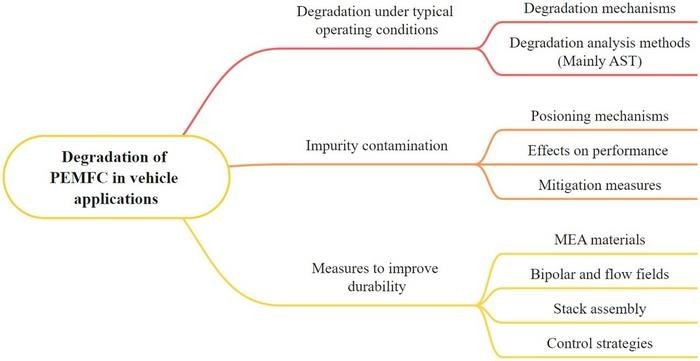Recent research explores considerable advancements in understanding the mechanisms of proton exchange membrane fuel cells (PEMFCs) designed for automotive applications. It focuses on improving the longevity and durability of PEMFC fuel cells in automotive settings, thereby addressing the main barriers preventing their widespread commercial adoption.
 The logic structure diagram of this paper. Image Credit: Zikuo Liu, et al.
The logic structure diagram of this paper. Image Credit: Zikuo Liu, et al.
At the forefront of clean energy solutions for automobiles are proton exchange membrane fuel cells (PEMFCs), which offer zero emissions, high efficiency, and low noise levels. Despite these benefits, substantial durability and lifespan challenges stand in the way of widespread adoption. The main cause of these difficulties is the fuel cells’ susceptibility to the unpredictable and frequently severe operating conditions of automobiles.
A recent review published on February 27th, 2024, in the journal Energy Storage and Saving, looks into the different ways that PEMFCs deteriorate in automotive environments. It provides techniques to improve the longevity of PEMFCs and highlights the use of accelerated stress testing techniques.
The research team carried out a thorough analysis of the challenges that PEMFCs encounter. These challenges included mechanical wear and tear brought on by fluctuating operational demands, as well as chemical breakdown of membranes caused by harsh reactions and corrosion of carbon supports essential for preserving cell integrity. The study also demonstrated how impurities, which are frequently overlooked, enter the system and hasten degradation, impeding the creation of long-lasting PEMFCs.
The research takes a direct approach to these problems and presents innovative solutions, such as using accelerated stress testing (AST) techniques. These techniques accurately replicate the harsh environments that PEMFCs face in real-world automotive applications and provide a thorough examination of a range of degradation mechanisms, including chemical, mechanical, and impurity-induced deteriorations. Recommendations for improving durability are given from a variety of angles.
Understanding and mitigating the degradation of PEMFCs in vehicle applications is crucial for realizing their full potential as a sustainable energy source. Our comprehensive analysis offers new perspectives and solutions to overcome the durability challenges, bringing us closer to commercializing this clean technology.
Zhengkai Tu, Research Team Leader, Huazhong University of Science and Technology
This approach illuminates the vulnerabilities of PEMFCs but also paves the way for innovating more resilient materials and designs. By addressing the Achilles' heel of PEMFCs, this research brings people closer to a future where clean, efficient, and durable fuel cells drive vehicles, representing a significant stride towards sustainable transportation.
Journal Reference:
Liu, Z., et al. (2024) Recent development in degradation mechanisms of proton exchange membrane fuel cells for vehicle applications: problems, progress, and perspectives. Energy Storage and Saving. doi.org/10.1016/j.enss.2024.02.005